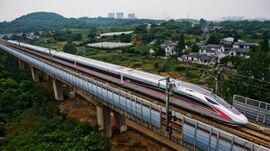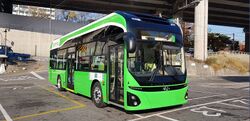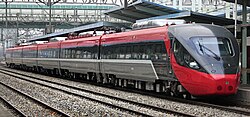Transport in Zhenia
Transport in Zhenia is primarily facilitated by road, rail, air and waterways (canals and rivers). Most intercity and long-distance travel happens through road, rail or air; short-distance travels are dominated by road and rail. Cargo transport within Zhenia happens through rail, road, boat, pipeline and air in descending order. Zhenia is well-known for one of the longest and most complex railroad networks in the world, connecting almost all of the nation while also expanding to nearby states. Zhenia has a hierarchy of roads spread throughout the nation, covering the majority of the nation. Zhenia, being home to the largest aviation industry in the world, has numerous regional and international airports, with the most notable being the Daedo Capital International Airport and Shin Jinhae International Airport. Transport within Zhenia across all modes of transportation is almost completely mechanized and, in the case of rail, electrified.
History
Before the 19th century
Dynasties in both mainland Zhenia and the Danguk Peninsula emphasized the need to establish and maintain adequate transport infrastructure as a means of consolidating centralized rule. The earliest records of large-scale transport infrastructure networks hint towards the existence of a nationwide post horse network, complete with a posthouse every hundred ri (Zhenian: 里) during the Zhen dynasty as a method to exert centralized rule from Jinyang, while a network of roads to support such post horse network, later named the Imperial Roads, were constructed by 200 CE. Some tracts of the Imperial Roads extended from Jinyang to modern-day Daeheung and was later connected to the silk road to the west. A network of transporting grains and other cargo from around the region to the capital as taxation was also built around the nation since the Zhen, utilizing both the Imperial Road system as well as many inland rivers and coastal ports. Water transport in the Danguk Peninsula and mainland Zhenia was used more frequently in later dynasties, especially following the completion of the Central Canal of Zhenia linking the Weisu River to the Taimir River around 665. The Central Canal, receiving multiple renovations and expansions over the centuries, remains in use to this day.
Following the historical division between the Danguk Peninsula and the mainland, direct road connections between the two nations were restricted, making the occasional ferries being virtually the only direct connection between the two entities. While many of the mainland dynasties focused on establishing road connections within the mainland and utilizing existing canal networks and inland rivers near the Taimir Basin, long-range maritime transport flourished in the Shindan dynasty, establishing permanent connections with its possessions with colonies and trading ports in western Veharia and the Hanmaric Ocean. Hamseon trade flourished between East Tarsis and western Veharia, significantly influencing the global flow of silver and gold that upheld the economic structure of both the Shindan and Greater Wu dynasties, as Shindanese ships maintained monopolies over many of the commodities coming from the east. Later years of the Shindan dynasty saw the reinstatement of the Imperial Roads network in the late 18th century, although they were mostly restricted to the Danguk Peninsula.
19th century
The 19th century became a major transition point for transport in Zhenia, amid the introduction of other modes of transportation, particularly during and after the Daeseong Reforms during the rule of Emperor Seongjo. While inland water transport, via both canals and inland rivers, were favored over long distances, road networks around the nation, although primarily for horse-driven carriages and wagons, were established around the Danguk Peninsula during the Shindan dynasty, resulting in a short golden age for inland depots and posthouses along the restored Imperial Roads. Some of the horse-driven carriages and wagons were placed on iron rails to solidify routes and increase efficiency of transport, although such applications were mostly seen near ports open to Auroran traders.
Transport in Zhenia was revolutionized in 1849, when the first railroad used by a steam-powered locomotive in Zhenian history, the Daedo-Seongnam Railway, commenced operations, connecting modern-day Daedo South Station and the Port of Seongnam. Construction of railroads skyrocketed during and after the Zhenian Civil War, with the major railroads still existent today, such as the Daedo-Gwangseong Railway and the Daedo-Changan Railway, commencing operations during the Zhenian Civil War, while the first railroad traversing the Golden Arc region between Gwangseong and Jinhae completed on August 3, 1868. The boom of railroads, while establishing quick, direct, scheduled and year-round spoke-and-hub transportation that interconnected the nation, helped in the industrialization of both Shindan and later the Empire of Zhenia, while also proliferating industrialization more inland from the Golden Arc region. Railway construction, ownership and operation were all initially spurred by private rail companies, although they were later nationalized and integrated into the Zhenia National Railway Company in 1903, consolidating national ownership and operation of railroads throughout the nation, although most passenger and freight services remained in the private sector until the Third Republic. Development of rail technology allowed for the proliferation of rail-based transportation as a means of urban transit, with the introduction of streetcars in major port cities towards the end of the century.
20th century
While rail transport reached its zenith in the early 20th century, the rapid proliferation of automobiles since the early 1900s immensely changed the landscape of transportation throughout the entire nation, with previously horse-dominated roads giving way to vehicles with gasoline-powered internal combustion engines, while roads in both urban and rural areas were widened to make way for the increased traffic.
After the Second Great War
Road Transportation
Motor vehicles

Much of road construction throughout Zhenian history was led by the state since the First Zhenian Republic, although they were initially less prioritized than rail construction. With the proliferation of personal cars and light trucks after the First Great War, however, extensive road plans to form a network of roads materialized into the National Road system, a grid of state-owned automobile routes connecting major cities of the Golden Arc region, as well as the Danguk Peninsula and Inland Zhenia. Road infrastructure in Zhenia saw further boosts during and after the Third Republic led by Kim Shimin, concentrating the construction effort on a network of controlled-access highways that connected the nation's major population and industrial centers.
Today, road transport remains one of the most commonly used means of transport for Zhenians, handling roughly 42% of all traffic nationwide: in 2019, 45.5% of all passenger movement and 21% of cargo transport within the nation occurred through road transport, with the percentage of motor vehicles accounting for road transport set to increase to 49.3% for passenger movement by 2035. 87% of all households in the nation have at least one car, while 40% own two or more; the figure, however, is significantly lower in densely populated major cities, where extensive mass transit and urban rail systems have been built, while the car ownership rate is set to somewhat increase amid the construction of suburban new towns near the outskirts of existing major cities.
Driving is on the right across all of Zhenia, although the maximum speed limit varies by region: mostly, maximum speed limits are higher on western and northern Zhenia, where traffic is less dense. Heavy vehicles, such as buses, semi trucks with cargo, dump trucks and construction vehicles, are subject to maximums speed limits that are 20% lower than the speed limit enforced in their respective regions for safety reasons. While there have been motions to utterly eliminate the speed limits in select roads throughout the nation, they have been met with great resistance amid safety concerns.
The continuous increase of motor vehicle usage and traffic in the nation overall has raised significant environmental concerns, including traffic congestion seen in almost all major cities and increasing greenhouse emissions. In order to curb the environmental footprint of motor vehicle usage, Zhenian cities have been expanding public transport services from densely populated urban centers to suburban areas, while it has been investing heavily in the proliferation of both electric and hydrogen-powered vehicles on the road; as of April 2020, over 2.3 million electric vehicles are said to be already on the road, while around 25,000 hydrogen-powered vehicles were already on Zhenian roads by the same year.
Expressway system
The National Expressway (Zhenia) and the Zhenia National Road systems together compose one of the most extensive controlled-access highway networks in the world. All National Expressways and National Road routes are owned and maintained by the Zhenia Expressway Corporation, which also oversees service amenities and the electric toll collection system of Zhenian expressways, while some smaller-volume roads were built through civilian investment and are contracted for civilian operation for a 30-year period. With its plans laid out before the Second Great War and much of the construction done during the Third Republic, the National Expressway system links all province-level districts and nearly all major cities to the rest of the nation. Comprising of over 70,000 kilometers upon the completion of its Third Phase in 2010, the system connects most of the nation's major cities and areas of production with one another, as a core component to the nation's economy.
Many of the National Expressway routes are often linked with one another directly or through branch roads under the Zhenia National Road System. Somewhat a predecessor to the National Expressway system, National Roads are in principle not toll roads and are more of limited-access roads, although they are regarded regular roads when they are in urban areas. Covering areas in which the National Expressway does not pass as well as providing alternate routes to the National Expressway, National Roads are a major component of road infrastructure connecting most accessible points within the nation.
Road passenger transport

Bus services, both local and intercity, are very commonplace in the nation, with local buses mostly covering prefecture-level areas and intercity coach services offering coverage to most parts of the nation. While many local buses are operated by private enterprises with local government subsidies, some services in major cities, such as Daedo, Hansan and Shinhang, see city-wide bus services operated by public enterprises or directly by the prefecture-level government. While bus rates are proportionate to the distance traveled by the same ticket, discounts to select user groups, such as students and the elderly. Most local bus services do not charge for transfers within 90 minutes of debarkation from the previous bus, although select express bus and bus rapid transit services in some cities operate under a separate fare system. Z Transit, a nationwide, RFID-based transportation card system, has been implemented for usage in any of the nation's bus services, both local and intercity, since 2006. In accordance to the nation's 'Green Transport' policies since 2005, many provincial and local governments are promoting the implementation of electric and other 'zero-emission' buses in their transport networks, aiming to have 70% of local buses in the nation to be electric by 2030.
Intercity bus services are separated into two services depending on their stops and operating conditions - intercity and express coach. Intercity buses take more stops than their express counterparts and do not need to cover over 60% of their travel distance by expressway, while express coaches additionally need to cover a distance greater than 100 km and need to operate at least 60% of their travel distance via expressway. Unlike local bus services, both intercity and express coach services, with the exception of some remote, rural areas in western and northern Zhenia, are operated primarily by the private sector, competing in thousands of routes across the nation. While somewhat unpopular compared to intercity rail in long-distance journeys due to long travel times and the introduction of the ZNX, most intercity and express coach services have recently focused on providing relatively short-to-mid-distance transport as alternatives to existing intercity and ZNX train services.
Passenger taxi services are very common in most cities throughout the nation, primarily offering direct point-to-point services. Both local taxi companies and publicly-licensed services are allowed to operate taxi services around the clock throughout the nation, with the permits usually assessed and assigned by prefecture-level government. Pre-booked charter taxis are also available, although they are primarily used for longer trips at least 150 km in length. The government subsidizes a selected subset of local taxi services to offer needs-based taxi services connecting urban/suburban areas and rural services without any other mode of public transportation, as part of the Essential Access Initiative, with such often being the most affordable modes of transport into urban areas from rural areas the initiative services. Ridesharing services have become common recently, fiercely competing for the precarious market share of much of the nation's taxi services in many of the nation's major cities, while experimentation regarding the usage of self-driving autonomous vehicles in taxi services is underway across the nation. On December 1, 2019, Shinhang became the first city in the nation to allow taxi operations by self-driving cars throughout the metropolitan municipality.
Road cargo transport
Although rail constitutes a considerable portion of all freight transport within the nation, transport of cargo through the nation of road networks via commercial motor vehicles, particularly semi-trucks, box trucks and dump trucks, remain as a widely-used method of transporting cargo. Cargo transport through road is a crucial component of the nation's economy in the transport of raw materials, intermediate products and finished goods over land, directly linking the areas of production with manufacturing plants and depots for retail distribution. Long-range trucking throughout the nation contributes to an average of 40% of all traffic in the National Expressway network, although the percentage can increase to around 65% depending on location and the time of day and year.
Rail
Rail remains one of the most commonly-used means of transport, with Zhenia's railways carrying over 2.1 trillion tonne-kilometers of freight and around 556.3 billion passenger-kilometers in 2015. Zhenia is home to strong rail infrastructure, with the first railroads dating back to the Empire of Zhenia. Being home to over 105,144 km of tracks as of 2015, Zhenia is home to some of the largest rail networks in the nation, almost all of which is owned and maintained by ZhenRail and its subsidiaries. Around 82.5% of the nation's rail network is electrified and almost all of its network double-tracked as of 2015, although the percentage of electrification is set to increase to 90.4% by 2025.
Intercity rail
Although it has declined in usage since the late 20th century following the establishment of the National Road and National Expressway systems as well as the introduction of passenger air services across the nation, rail remains one of the most commonly-used modes of intercity passenger transport. Intercity rail services provide high coverage in most parts of the nation, with all province-level administrative divisions and cities with a population of over 500,000 seeing passenger rail services at least once a day. While ZhenRail retains ownership and service rights over most intercity rail services, some services are operated by private rail companies, and companies funded by both regional governments and private companies.
Regardless of the operator, all intercity rail services are given the designation 'ITX' to signify their role as providers of intercity rail transit, which, in the case of ZhenRail-operated services, act as a prefix to the service names; each operator can add different names to differentiate it from other services. Intercity rail services in Zhenia are categorized into one of the three following types according to the type of service they provide - local, rapid and express. The three levels are normally differentiated by the type and number of stops as well as their travel distance, with local trains tending to make the most stops and operate shorter routes while express trains tend to make minimal stops and often operate routes that traverse the nation. Some local and rapid train services with routes directly traversing major cities also complement existing commuter rail services to connect rural and suburban areas to high-density urban areas.
High-speed rail
The Zhenia National Express is the nation's primary high-speed rail service, as well as one of the first dedicated high-speed rail services in the world. Commencing service in 1974, it has received extensive funding and support from the government, consisting of over 20,000 kilometers of tracks and transporting over 1.5 billion passengers each year. Primarily connecting the nation's population centers both inland and along the Golden Arc region. Due to prioritization of high-speed rail transport in signalling and traffic due to ZhenRail's ownership over almost all passenger tracks in Zhenia, ZNX trains are well-known for their punctuality, with 99.2% of all ZNX services arriving and departing no later than 5 minutes on average. ZNX technology has also been attempted for international export several times, successfully exporting its technology to Toloria and Educandi.
The first ZNX services commenced operations between Daedo and Changan in 1974, reducing the travel time between the two cities from the previous 7 hours and 58 minutes with conventional rail service to around 4 hours and 25 minutes. Service in several other dedicated high-speed lines followed suit, further reducing travel times between the nation's major cities by rail. Further developments to introduce faster Maglev trains into high-demand routes, such as the Daedo-Changan route or those along the Golden Arc region, are underway, with initial operation expected to commence around 2025.
Cargo
International rail connections
Urban rail
A total of 32 cities across the nation operate their own rapid transit services, while an additional 58 operate their own light rail or tram transit lines of any form in urban areas. The Daedo Metropolitan Subway, the oldest and largest urban rail transit system in the nation, is also one of the world's largest both by ridership and by length. There are subway systems in other major cities, including Jinhae, Changan, Shinhang, Bakhan, Ariul, Geonju and Zhuhae, while numerous smaller cities also make use of light rail services to connect urban areas with suburban residential areas.
Bridges
Air

The Zhenian aviation industry is one of the largest in the world, with almost 1 billion passengers flying on domestic or international routes as of 2019. With 361 airports officially in operation within the nation, Zhenia is one of the most connected nations in the world, flying to all six major continents via direct flight. Although there are numerous smaller airfields scattered across the nation, only 361 are officially recognized as airports by the Ministry of Transportation. The nation's major international gateways are Daedo Capital International Airport (Daedo), Shin Jinhae International Airport (Jinhae and the Taimir River Delta area) and the Changan International Airport (Changan); other major traffic hubs in the nation include Ariul International Airport, Kim Shimin International Airport outside Dongdo and Shinhang International Airport.
Although there are three full-service carriers (FSC) and 13 low-cost carriers (LCC) operating in the nation, the nation's official flag carrier remains to be Zhenian Airways, a full-service carrier that formerly a nationalized airline until 1998. It is one of the few airlines in the world offering flights all six continents, with 360 destinations over 85 nations.
Maritime
[[Port of Jinhae South View.jpg|250px|thumb|right|The Port of Jinhae is widely regarded as one of the busiest ports in the world.]]
Located in the eastern seaboard of Tarsis, Zhenia is a major seafaring nation, being home to one of the world's largest shipbuilding industries and some of the world's busiest ports by cargo loading. It has over 1,500 ports, almost 700 of which are designated as international trade ports open to foreign ships. Among the busiest ports by cargo loading capacity include Daedo, Jinhae, Shinhang, Dongdo, Jin-Nampo, Zhuhae, Bukju and Suripo.
While there are a considerable amount of ferry services connecting the nation's many islands in the Gulf of Danguk and the East Zhenian Sea, as well as services across the Gulf, a considerable amount of maritime traffic in Zhenia is dedicated to cargo transport. With most of the nation's major rivers, including the Taimir and Weisu rivers, navigable, inland water transport is frequently used as the primary means to transport cargo and resources from central Zhenia to the Gulf of Danguk and beyond, with inland river ports acting as entrepots prior to export.







